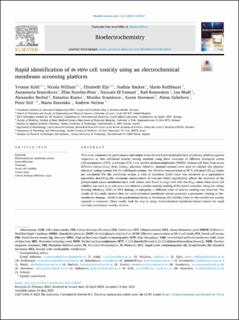| dc.contributor.author | Kohl, Yvonne | |
| dc.contributor.author | William, Nicola | |
| dc.contributor.author | Elje, Elisabeth | |
| dc.contributor.author | Backes, Nadine | |
| dc.contributor.author | Rothbauer, Mario | |
| dc.contributor.author | Srancikova, Annamaria | |
| dc.contributor.author | Rundén-Pran, Elise | |
| dc.contributor.author | El Yamani, Naouale | |
| dc.contributor.author | Korenstein, Rafi | |
| dc.contributor.author | Madi, Lea | |
| dc.contributor.author | Barbul, Alexander | |
| dc.contributor.author | Kozics, Katarina | |
| dc.contributor.author | Sramkova, Monika | |
| dc.contributor.author | Steenson, Karen | |
| dc.contributor.author | Gabelova, Alena | |
| dc.contributor.author | Ertl, Peter | |
| dc.contributor.author | Dusinska, Maria | |
| dc.contributor.author | Nelson, Andrew | |
| dc.date.accessioned | 2023-07-10T11:38:30Z | |
| dc.date.available | 2023-07-10T11:38:30Z | |
| dc.date.created | 2023-06-14T12:23:33Z | |
| dc.date.issued | 2023 | |
| dc.identifier.citation | Bioelectrochemistry. 2023, 153, 108467. | en_US |
| dc.identifier.issn | 1567-5394 | |
| dc.identifier.uri | https://hdl.handle.net/11250/3077469 | |
| dc.description.abstract | This study compares the performance and output of an electrochemical phospholipid membrane platform against respective in vitro cell-based toxicity testing methods using three toxicants of different biological action (chlorpromazine (CPZ), colchicine (COL) and methyl methanesulphonate (MMS)). Human cell lines from seven different tissues (lung, liver, kidney, placenta, intestine, immune system) were used to validate this physicochemical testing system. For the cell-based systems, the effective concentration at 50 % cell death (EC50) values are calculated. For the membrane sensor, a limit of detection (LoD) value was extracted as a quantitative parameter describing the minimum concentration of toxicant which significantly affects the structure of the phospholipid sensor membrane layer. LoD values were found to align well with the EC50 values when acute cell viability was used as an end-point and showed a similar toxicity ranking of the tested toxicants. Using the colony forming efficiency (CFE) or DNA damage as end-point, a different order of toxicity ranking was observed. The results of this study showed that the electrochemical membrane sensor generates a parameter relating to biomembrane damage, which is the predominant factor in decreasing cell viability when in vitro models are acutely exposed to toxicants. These results lead the way to using electrochemical membrane-based sensors for rapid relevant preliminary toxicity screens. | en_US |
| dc.language.iso | eng | en_US |
| dc.rights | Navngivelse 4.0 Internasjonal | * |
| dc.rights.uri | http://creativecommons.org/licenses/by/4.0/deed.no | * |
| dc.title | Rapid identification of in vitro cell toxicity using an electrochemical membrane screening platform | en_US |
| dc.title.alternative | Rapid identification of in vitro cell toxicity using an electrochemical membrane screening platform | en_US |
| dc.type | Peer reviewed | en_US |
| dc.type | Journal article | en_US |
| dc.description.version | publishedVersion | en_US |
| dc.rights.holder | © 2023 The Author(s). Published by Elsevier B.V. | en_US |
| dc.source.pagenumber | 11 | en_US |
| dc.source.volume | 153 | en_US |
| dc.source.journal | Bioelectrochemistry | en_US |
| dc.identifier.doi | 10.1016/j.bioelechem.2023.108467 | |
| dc.identifier.cristin | 2154415 | |
| dc.source.articlenumber | 108467 | en_US |
| cristin.ispublished | true | |
| cristin.fulltext | original | |
| cristin.qualitycode | 1 | |

